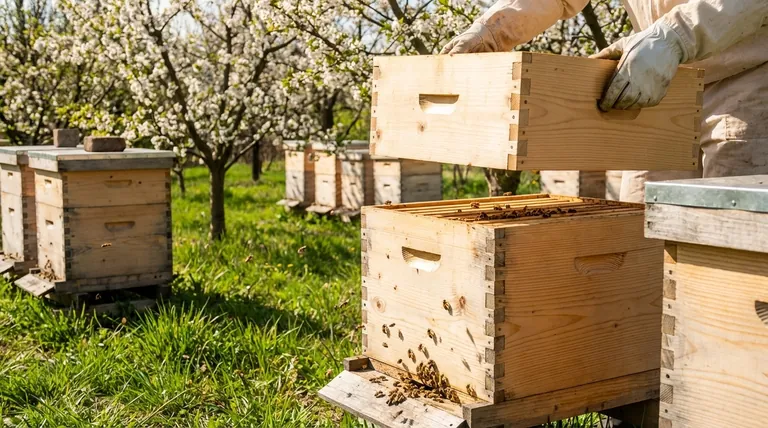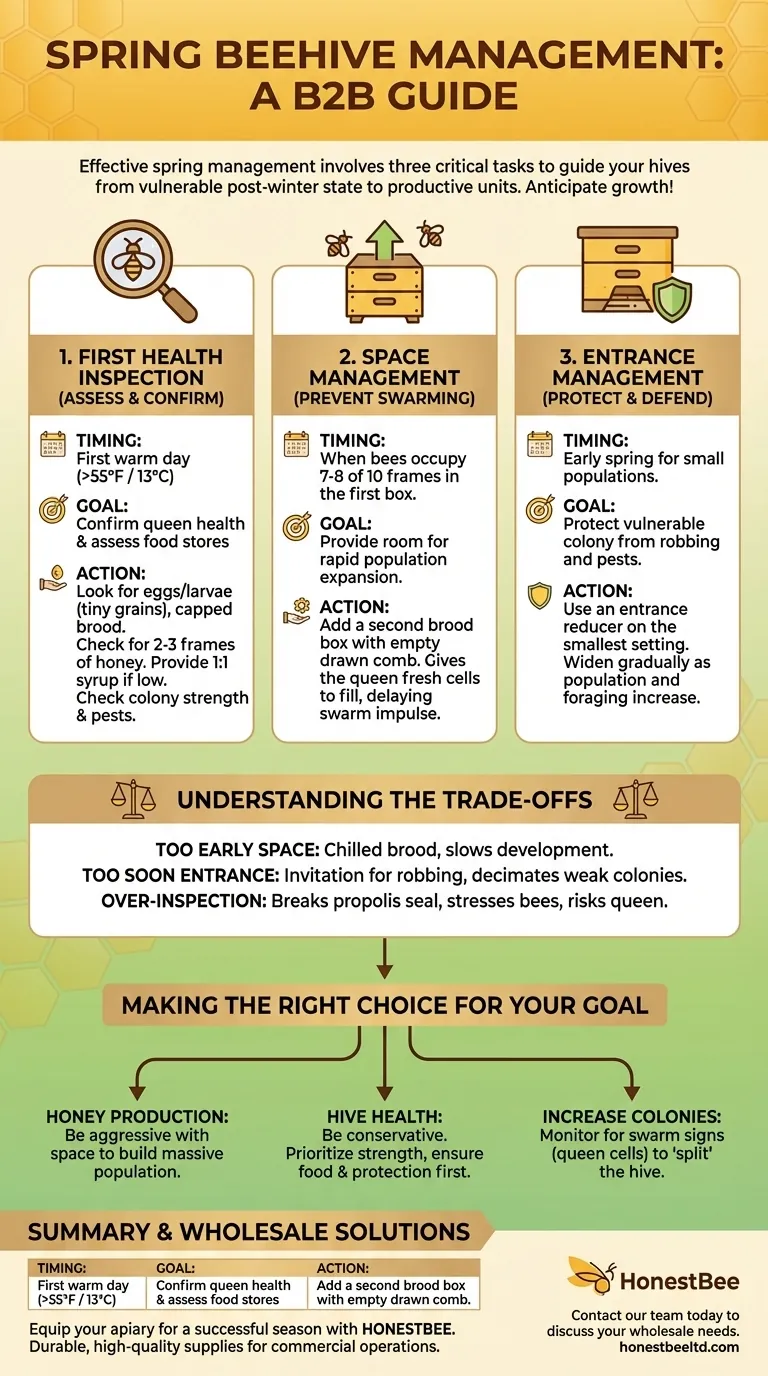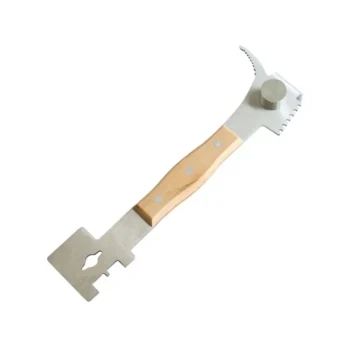In short, effective spring beehive management revolves around three critical tasks: verifying the health of your queen and assessing food stores, providing adequate space for the rapidly expanding population, and managing the hive entrance to protect the growing colony. These actions are not just routine checks; they are strategic interventions designed to guide the hive from its vulnerable post-winter state into a strong, productive unit for the season ahead.
Your primary role in spring is not just to inspect, but to anticipate. You are managing the colony's explosive growth to build a strong, productive hive while protecting it during its most vulnerable transition period.

The First Inspection: Assessing Post-Winter Health
Your first warm day in spring (consistently above 55°F or 13°C) is the time for a quick but thorough inspection. The goal is to assess the colony's core health without causing unnecessary stress or chilling the brood.
Confirming a Healthy Queen
The queen is the engine of the hive. You must confirm she survived the winter and is actively laying.
You don't need to physically see the queen. Look for the evidence she leaves behind: frames containing eggs (tiny, rice-like grains at the bottom of cells), larvae, and capped brood in a solid, concentrated pattern.
Assessing Food Stores
The colony's winter food supply is likely depleted. Brood rearing requires an enormous amount of energy, and a cold snap can quickly lead to starvation even if flowers are beginning to bloom.
Ensure the hive has at least two to three full frames of honey. If stores are low, you must provide supplemental feeding with a 1:1 sugar-water syrup to fuel their expansion until the first major nectar flow begins.
Checking Overall Colony Strength
A healthy hive should be actively building up. Observe the number of frames covered by bees. A weak colony with only a few frames of bees may struggle to stay warm and defend itself.
This is also the time for an initial check for diseases or pests like Varroa mites. A strong, healthy colony is the best defense.
Managing Space to Prevent Swarming
As the queen ramps up egg-laying, the hive's population can explode. A crowded hive is the primary trigger for swarming, where the old queen leaves with half the bees to find a new home. Your job is to provide space before they feel crowded.
The Purpose of the Brood Box
The brood box is the heart of the colony—its nursery and living quarters. You must ensure it is in good condition and has enough empty, drawn-out comb for the queen to lay eggs.
If your colony overwintered in a single brood box, it will need a second one very soon. A common rule is to add a second brood box when bees have drawn out comb and are using seven or eight of the ten frames in the first box.
Giving the Queen Room to Expand
Adding a new box on top of the existing one provides immediate space. This simple act gives the expanding population room to work and gives the queen fresh cells to fill, which can delay or prevent the swarm impulse.
Protecting the Vulnerable Colony
A growing colony is a target. In early spring, your hive is still relatively small and can be overwhelmed by robber bees from stronger hives or by pests.
Why Entrance Size Matters
A large entrance is difficult for a small population to defend. By reducing the entrance, you create a smaller, more defensible "front door."
As the colony's population grows and foraging activity increases, the entrance can be gradually widened to prevent traffic jams and improve ventilation.
Using an Entrance Reducer
Most beekeepers use a simple wooden block called an entrance reducer. In early spring, set it to the smallest opening.
As the weeks pass and you see a dramatic increase in bee numbers and foraging traffic, you can rotate it to a larger opening or remove it entirely during the main nectar flow.
Understanding the Trade-offs
Spring management is a balancing act. Acting too soon or too late can have negative consequences for the colony.
The Risk of Adding Space Too Early
Giving the hive a second box before they are ready creates a large, empty space that the bees cannot effectively heat. This can lead to chilled brood, stressing the colony and slowing its development.
The Danger of Opening the Entrance Too Soon
Widening the entrance before the colony has the population to defend it is an open invitation for robbing. A robbing frenzy can decimate a weak colony in a matter of hours.
The Problem of Over-Inspection
While inspections are necessary, opening the hive too frequently breaks the propolis seal, disrupts the colony's climate, and stresses the bees. It also increases the risk of accidentally crushing or "chilling" the queen. Be efficient and purposeful with every inspection.
Making the Right Choice for Your Goal
Your specific actions should align with your beekeeping objectives for the season.
- If your primary focus is maximizing honey production: Be aggressive with space management. Add new boxes just ahead of the bees' needs to build a massive population that can capitalize on the main nectar flow.
- If your primary focus is hive health and survival: Be more conservative. Prioritize colony strength over expansion, ensuring they have ample food and are protected from robbing before adding significant space.
- If your primary focus is increasing your number of colonies: Monitor the hive for signs of swarm preparation (like building queen cells) and use this impulse to "split" the hive, creating two colonies from one.
By understanding the colony's natural spring cycle, you can work with your bees to ensure they become a healthy and productive hive.
Summary Table:
| Key Spring Task | Primary Goal | Critical Timing / Indicator |
|---|---|---|
| First Health Inspection | Confirm queen health & assess food stores | First warm day (>55°F / 13°C); look for eggs/larvae |
| Space Management | Prevent swarming by providing room for expansion | Add a second brood box when 7-8 frames are occupied |
| Entrance Management | Protect the vulnerable colony from robbing & pests | Use a reducer on the smallest setting initially |
Equip your apiary for a successful season with HONESTBEE.
Spring is a critical time for your hives, and having the right equipment is essential for effective management. As a trusted wholesale supplier for commercial apiaries and beekeeping equipment distributors, HONESTBEE provides the durable, high-quality supplies you need—from brood boxes and entrance reducers to full hive kits and feeding systems.
Let us help you build stronger, more productive colonies. Contact our team today to discuss your wholesale needs and ensure your operation is ready for peak productivity.
Visual Guide

Related Products
- Wholesales Dadant Size Wooden Bee Hives for Beekeeping
- Professional Grade Foldable Beehive Handles
- Premium Comfort Grip Spring-Loaded Hive Handles
- Black Plastic Beetle Barn Hive Beetle Trap for Beehives
- HONESTBEE Classic Pry Bar Hive Tool with High Visibility Finish for Beekeeping
People Also Ask
- What should you do if you find an ant nest near your beehive? Essential Strategies for Hive Protection
- What is the best place to keep bees? Find the Perfect Apiary Site for Your Hives
- What should beginners consider when purchasing beekeeping equipment? A Guide to Essential Starter Gear
- What is beekeeping equipment? Essential Tools for Commercial Apiaries & Distributors
- What are the characteristics of oil-based paint for beehives? Durability vs. Modern Practicality



















